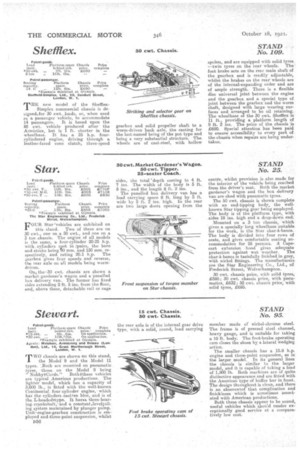Stewart.
Page 52

If you've noticed an error in this article please click here to report it so we can fix it.
15 cwt. Chassis. 50 cwt. Chassis.
STAND No. 95.
fr WO chassis are shown on this stand, I the Model' 9 and the Model 11 types. .Both are mounted on pneumatic tyres, those on the Model 9 being
NobbrCords." Bothithese vehicles are typical American productions. The lighter model, which has a capacity of 3,000 lb., is fitted with the well-known Continental four cylinder engine,which has the cylinders.castfen bloc, and is of the L-headedetype. It hassa three-bearing. crankshaft? -and a constant level t oiling system maintained by plunger pump. Unit-engine-gearbox construction is employed and-three-point suspension, whilst
the rear axle is of the internal gear drive type, with a solid, round, load carrying
member made of nickel-chrome steel. The frame is of pressed steel channel, heavy gauge, and is suitable for taking a 10 ft. body. The foot-brake operating cam closes the shoes by, a lateral wedging action.
The smaller chassis has a 15.9 h.p. engine and, three-point suspension, as in the larger model. In its general lines the chassis is similar to the larger model, and it is capable of taking a load of 1,500 lb. Both machines are of quite distinctive appearance and are fitted with the American type of buffer bar in front. The design throughout is clean, and there is an absence'rof that complication and finickiness which is sometimes associated with American productions. Both these chassis appear to be sound, useful vehicles which sikould render exceptionally good service at a comparatively low cost.
































































